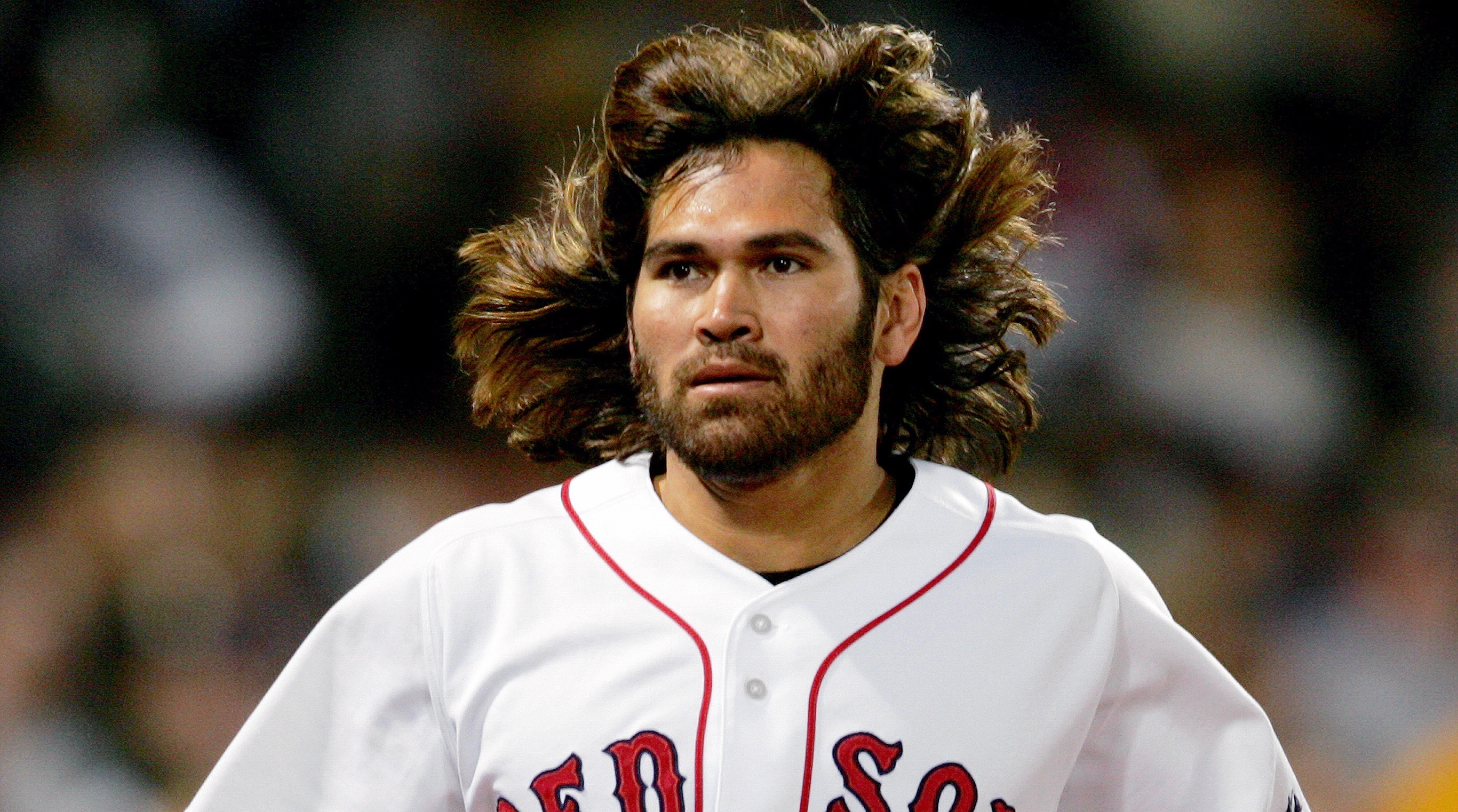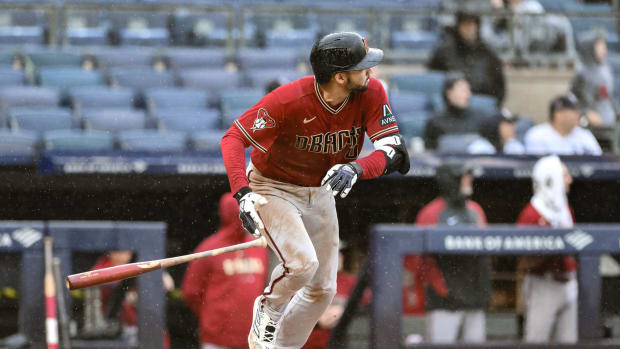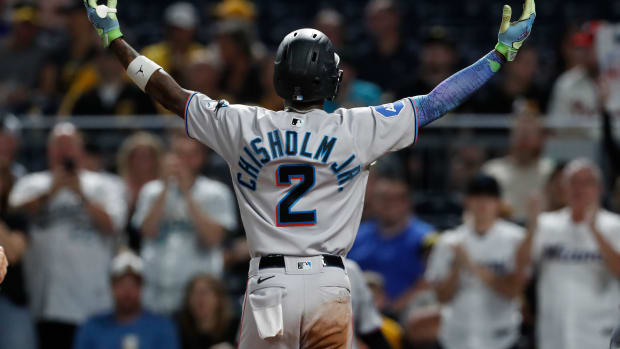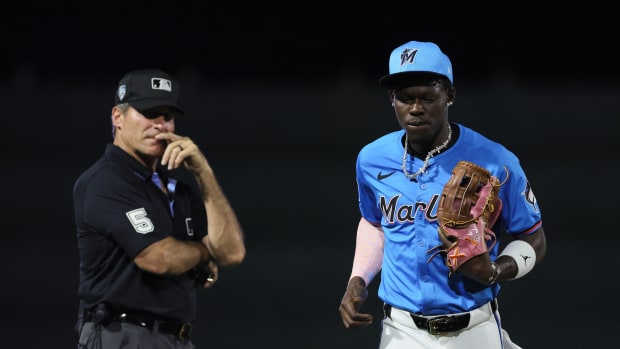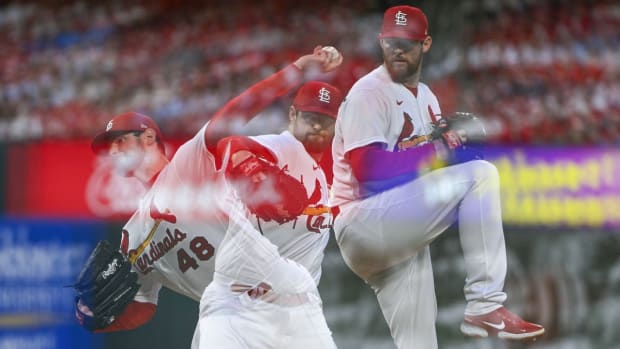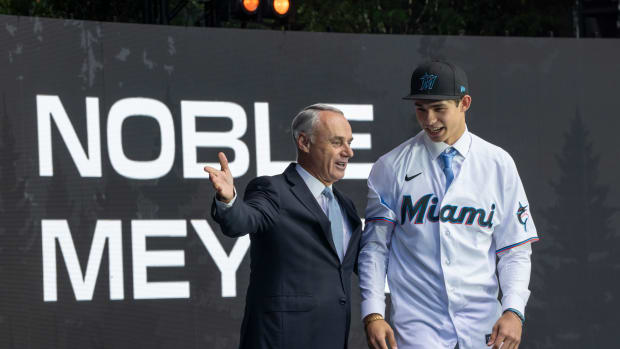One-and-Dones Pt. 3: Johnny Damon, Hideki Matsui Were Popular, but not Hall of Famers
The following article is part of my ongoing look at the candidates on the BBWAA 2018 Hall of Fame ballot. For a detailed introduction to this year's ballot, please see here. For an introduction to JAWS, see here.
Wrapping up the final phase of my 2018 BBWAA Hall of Fame ballot breakdown, here is the third installment of first-time candidates whose stays on the ballot will be short, as they won’t receive even the 5% of the vote necessary to retain eligibility. That’s no great injustice, given that with one exception—that’s one out of 13 one-and-done players, from among the 33 total on the ballot—their JAWS are at least 20 points below the standards at their positions. All the same, these players' careers are worth another look before they head into the sunset. Some were Hall of Fame-caliber talents whose bodies couldn’t hold together for long enough to make a serious bid for Cooperstown. Others were late-bloomers for whom reaching the 10-year minimum required to appear on the ballot was a triumph unto itself. Many of them will be most fondly remembered as part of championship teams.
My annual project would not be complete without including them. This is the 15th year I’ve evaluated candidates using JAWS (which didn’t acquire its catchy name until a little over a year in), and I’ve never let one go by. After covering four pitchers in the firsttwo installments, it’s time to run through the position players.
Player | Career WAR | Peak WAR | JAWS | Hits | HR | SB | Avg/OBP/SLG | OPS+ |
Aubrey Huff | 20.2 | 22.5 | 21.4 | 1,699 | 242 | 37 | .278/.342/.464 | 114 |
Avg. HOF 1B | 66.4 | 42.7 | 54.6 |
|
|
|
|
|
Orlando Hudson | 30.9 | 27.2 | 29.1 | 1,319 | 93 | 85 | .273/.341/.412 | 97 |
Avg. HOF 2B | 69.4 | 44.5 | 56.9 |
|
|
|
|
|
Carlos Lee | 28.2 | 23.4 | 25.8 | 2,273 | 358 | 125 | .285/.339/.483 | 113 |
Hideki Matsui | 21.3 | 21.3 | 21.3 | 1,253 | 175 | 13 | .282/.360/.462 | 118 |
Avg. HOF LF | 65.2 | 41.5 | 53.3 |
|
|
|
|
|
Johnny Damon | 56.0 | 32.9 | 44.4 | 2,769 | 235 | 408 | .284/.352/.433 | 104 |
Avg. HOF CF | 71.2 | 44.6 | 57.9 |
|
|
|
|
|
Aubrey Huff
From a sub-replacement level Devil Ray to a down-ballot MVP vote recipient for the world champion Giants, Aubrey Huff ran the gamut during a 13-year career as a four-corner player—first and third base, left and rightfield—for five different teams. Though he never made an All-Star team, he did win the 2008 Edgar Martinez award as the AL's top designated hitter, and had some big moments in the 2010 World Series against the Rangers. After his career ended, he offered some harrowing insights into his ups and downs—alcohol and Adderall abuse, gambling, marital woes, anxiety and depression—via his 2017 autobiography, Baseball Junkie.
A fifth-round pick out of the University of Miami in 1998, Huff was 23 years old when he debuted with the Devil Rays on August 2, 2000, playing 39 games for the third-year expansion team. Still a rookie in 2001, he hit an anemic .248/.288/.372 with eight homers, a 75 OPS+ and -0.8 WAR for a 100-loss team, a performance that returned him to Triple A to start 2002. He returned a much-improved hitter, batting combined .307/.364/.524 for a 135 OPS+ while averaging 29 homers and 3.6 WAR from 2002–04. After a downturn in 2005 and a rebound in '06, he was traded to the Astros, freeing him from a team that averaged 98 losses during his five full seasons. Though the Astros fell short of winning the NL Central, Huff's solid .267/.344/.469 showing with 21 homers netted him a three-year, $20 million deal with the Orioles.
One-and-Dones Pt. 2: A Look Back at the Best Times of Kerry Wood, Jamie Moyer and More
Huff sandwiched one very good season (.304/.360/.552 with 32 homers and 4.1 WAR) amid two lousy ones (a combined -0.7 WAR) in Baltimore, and did even worse after being traded to the Tigers in August 2009. In his autobiography, he admitted that during his time with the Orioles, he became hooked on Adderall (a stimulant used to treat attention deficit hyperactivity disorder, classified by MLB as a banned substance without a therapeutic use exemption, which is apparently easy to obtain) and drank excessively. Amid the mess of his personal life, he caught on with the Giants in 2010; splitting time between first base and both outfield corners, "Huff Daddy" emerged as one of the team's most popular players, hitting .290/.385/.506 with 26 homers and career highs in OPS+ (142) and WAR (5.7). He ranked ninth in the league in the latter category, placed seventh in the MVP voting and gained a level of notoriety for wearing his lucky red "rally thong" in September and October. Unexceptional in the first two rounds of the playoffs, he went 5-for-17 with three extra-base hits in the World Series, going 3-for-4 in Game 1 and hitting a two-run homer in Game 4.
Though Huff entered a drug and alcohol rehab clinic following the World Series, and netted a two-year, $22 million deal with the Giants, he struggled both on and off the field in 2011, continuing his Adderall abuse and dealing with marital issues. While he was able to quit the drug and save his marriage, in April 2012, he was diagnosed with an anxiety disorder. Between that and a right knee sprain suffered while tripping over the dugout rail following the final out of Matt Cain's perfect game, he homered just once in 52 games for the Giants that year while batting .192/.326/.282. Nonetheless, he made the postseason roster as a reserve as the Giants beat the Tigers in the World Series. He never did play again, though after continuing to battle his demons and even contemplating suicide in 2014, he mulled a comeback attempt for 2016.
Orlando Hudson
Before he'd ever played a major league game, Orlando Hudson gained notoriety for referring to Blue Jays general manager J.P. Ricciardi as a "smooth looking cat [who] looks like a pimp back in his day." Despite that inauspicious beginning, the slick-fielding "O-Dog" spent more than half a decade as one of the game's top second basemen, winning four Gold Gloves and making two All-Star teams.
A 43rd-round draft-and-follow out of Spartanburg Methodist College in 1997, Hudson was one of four players battling for the Blue Jays' second base job in the spring of 2002, having risen to No. 81 on Baseball America's Top 100 Prospects list. It was his hitless spring, not his comment about Ricciardi, that got him sent out. He debuted on July 24 of that year and hit .276/.319/.443 in 54 games. Over the next three years, he held down the Jays' second base job, hitting a combined .269/.335/.416 for a modest 93 OPS+ accompanied by 21 Defensive Runs Saved per year, a package with an average of 4.0 WAR. His career high of 5.2 in 2004 ranked eighth in the AL, and he won his first Gold Glove in 2005. That winter, he was traded to the Diamondbacks as part of a four-player deal that sent Troy Glaus to Toronto.
One-and-Dones Pt. 1: Remembering the Careers of Chris Carpenter, Livan Hernandez and More
Perhaps it was the hitter-friendly environment, but Hudson's bat perked up in Arizona, as he topped a 100 OPS+ in all three seasons with Arizona, hitting a combined .294/365/.448 for a 105 OPS+ while averaging 11 homers and eight steals. He won Gold Gloves in 2006 and '07 and made his first All-Star team in the latter year while helping the Diamondbacks to the NL West title. Unfortunately, both his 2007 and '08 seasons ended on the operating table, the former in early September due to a torn ligament in his left thumb, the latter in early August due to a left wrist fracture and dislocation. The Diamondbacks let him depart via free agency, and he initially sought a five-year, $50 million deal, but his Type A status—which meant that the signing team lost a draft pick—crushed his market; in late February, he agreed to a one-year deal with the Dodgers, worth $3.6 million plus another $4.6 million in incentives. He earned All-Star and Gold Glove honors while hitting .283/.357/.417 with 4.1 WAR for a team that got as far as the NLCS, though he spent the postseason coming off the bench while hot-hitting August 31 acquisition Ronnie Belliard started.
In a move that perfectly encapsulated the cheapskate tenure of Dodgers owner Frank McCourt, the team didn't offer Hudson arbitration out of fear he would accept, and couldn't recoup the draft pick when he signed elsewhere. He got just a one-year, $5 million deal from the Twins—a meager payday for a player whose 26.5 WAR from 2003-09 ranked fourth among all second basemen—whom he helped to a division title, though his OPS+ slipped from 109 to 96. He signed a two-year, $11.5 million deal with the Padres; battling a hamstring injury, his decline on both sides of the ball continued to the point that he was released in May 2012, having produced just 0.6 WAR in 154 games. Though he caught on with the White Sox, his .197/.262/.307 showing in 54 games effectively ended his career at age 34; winter 2013–14 stints in Mexico and the Dominican Republic failed to drum up further interest.
Carlos Lee
Panamanian Carlos Lee spent more than a decade as one of the majors' big boppers, mashing 331 homers from 1999–2010 (14th in MLB) while tipping the scales at 270 pounds or more, to the point that his contract included a weight clause. "El Caballo" drove in more than 100 runs six times and made three All-Star teams, but only once did he make a trip to the postseason.
Lee signed with the White Sox as a 17-year-old in 1994. Showing good power in the minors, he cracked Baseball America's Top 100 Prospects list in 1998 and '99 (number 28), and after just 25 games at Triple A, joined the White Sox on May 7, 1999, homering off A's knuckleballer Tom Candiotti in his first major league plate appearance. Lee hit .293/.312/.463 with 16 homers but a ghastly 72/13 strikeout-to-walk ratio as a 23-year-old rookie. He showed much better plate discipline the following year, hitting .301/345/.484 with 24 homers, 13 steals and a 94/38 K/BB ratio while helping the White Sox win the AL Central.
That kicked off a five-year span in which Lee averaged 27 homers, 12 steals, 3.0 WAR and a 114 OPS+ (.287/.344/.493); he hit 31 homers apiece in 2003 and '04, with a career best 5.0 WAR in the latter season. In a sense, he peaked too early, because that winter, the White Sox traded him to the Brewers in a four-player deal that brought back Scott Podsednik, whose (overrated) combination of speed and defense overshadowed the power that helped the team win its first World Series in 88 years.
Lee hit 32 homers and made his first All-Star team in 2005, then, after having his $8.5 million club option picked up, added 28 more homers in 102 games in '06 before being dealt to the Rangers on July 28 in a six-player swap that also included his understudy, Nelson Cruz. Though the Rangers fell short of winning the AL West, his nine homers helped him set a new career high with 37 to go with a .300/.355/.540 line and 3.1 WAR. The 31-year-old Lee parlayed that performance into a six-year, $100 million deal with the Astros, who were already one of the league's oldest teams. Though he hit very well through his first three seasons in Houston (.305/.354/.524 for a 128 OPS+) while averaging 29 homers, declining defense and baserunning limited him to 2.3 WAR per year.
The 34-year-old Lee's performance took a huge tumble in 2010, all the way to -2.2 WAR thanks to a 91 OPS+ and -17 Defensive Runs Saved. His downward spiral continued into the early months of 2011, but he rebounded, aided by a midseason move to first base. He finished with 4.0 WAR thanks to a 117 OPS+ (albeit with just 18 homers, his lowest total since 1999) and a surprising +14 DRS. Alas, his performance plunged back to replacement level in 2012; dealt to the Marlins on July 4, he slugged .325 in his final half season of major league play.
Hideki Matsui
Just the second Japanese position player to become an All-Star—Ichiro Suzuki was the first—Hideki Matsui arrived stateside to much fanfare in 2003, accompanied by a memorable nickname ("Godzilla") and a three-year, $21 million deal with the Yankees. He made the AL All-Star team in each of his first two seasons, helped the Bronx Bomber to a pair of pennants and a championship, and won World Series MVP honors in 2009 before departing for free agency. His 175 homers are the most of any Japanese-born player in MLB.
Matsui's size (6' 2", 210 pounds) and power (332 homers with a high of 50) earned him the "Godzilla" nickname during his decade with the Yomiuri Giants (1993–2002), during which he made nine straight All-Star teams, led the Central League in homers three times and won three MVP awards. After turning down a six-year, $64 million deal from the Giants in 2001, he left Japan to sign with the Yankees, heading into his age-29 season. He quickly endeared himself to fans by hitting a grand slam in the team's home opener, and drove in 106 runs while batting .287/.353/435 with 2.2 WAR. He made the AL All-Star team, helped the Yankees win the AL East, and hit .281/.347/.438 with 11 RBIs during the team's postseason run, delivering decisive homers in Game 3 of the Division Series against the Twins and Game 2 of the World Series against the Marlins.
Powerful and Volatile, Gary Sheffield's Hall of Fame Chances Are Slim
Matsui had his best season in 2004, hitting .298/.390/.522 with highs in homers (31), OPS+ (137) and WAR (5.0) that he would never surpass. Red-hot during the postseason, he hit .412/.456/.765 with seven doubles, three homers and 13 RBI in the postseason; he drove in five runs apiece in Games 1 and three of the ALCS against the Red Sox, though the Yankees ultimately squandered their three-games-to-none advantage.
After a strong 2005 (23 HR, 130 OPS+, 4.5 WAR) that netted him a four-year, $52 million extension, Matsui lost four months of the 2006 season to a broken left wrist suffered while diving for a ball on May 11. The injury, which required surgery, ended an iron man streak of 1,768 games dating back to his rookie season in Japan, when he was 19. A return to form in 2007 (25 HR, 123 OPS+, 4.1 WAR) was followed by a season battling an arthritic left knee that limited him to 93 games (just 23 in the outfield) and ended on the operating table in late September. As a full-time DH, he returned to club 28 homers and hit for a typical 123 OPS+ (.274/.367/.509) in 2009. His two-run homer off the Twins’ Francisco Liriano broke open the Division Series opener, and he went 8-for-13 with three homers against the Phillies in the World Series, one was a pinch-hit shot in Game 3 and the other two were game-winners off Pedro Martinez in Games 2 and 6. For his career, he hit .312/.39/.541 with 10 homers and 39 RBI in 235 postseason plate appearances.
With the Yankees only willing to bring back the going-on-36-year-old Matsui as a DH, he departed via free agency. He made good on a one-year, $6 million deal with the Angels (21 HR, 126 OPS+), but struggled on another one-year deal with the A's, slugging just .375 with 12 homers. Unable to find a major league deal for 2012, he signed a minor league deal with the Rays on April 30; he spent less than two months in the majors and retired that winter.
Between NPB and MLB, Matsui totaled 508 homers and 2,655 hits. While he won't make it to Cooperstown, he's considered a good bet to be elected to the Japanese Baseball Hall of Fame this year, his first year of eligibility. Only four players, including NPB home run king Sadaharu Oh and NPB-to-MLB pioneer Hideo Nomo have been elected in their first year.
Johnny Damon
A charismatic centerfielder who won championships with the Red Sox and Yankees and reached the playoffs eight times with four teams from 1995 to 2012, Johnny Damon is the one player from among this year's 13 one-and-dones who probably deserved a full-length profile. Generally, my cutoff for non-relievers is for players within 20 points of the JAWS standard; Damon is 13.5 points below, but between the December holiday schedule and the unlikelihood of his election—he's received just one vote from among the first 117 ballots published—I chose the path of least resistance. Though well-regarded, Damon made just two All-Star teams, cracked the top 10 in WAR just once, and nearly wound up a test case for whether a player who reached 3,000 hits deserved automatic enshrinement.
A supplemental first-round pick by the Royals in 1992, Damon—who was chosen out of an Orlando, Florida high school—made Baseball America's Top 100 Prospects list in each of the next three seasons, climbing to No. 9 in 1995. He debuted on August 12 of that season, hitting .282/.324/.441 with three homers and seven steals in 47 games as a 21-year-old. His progress over the next three seasons was uneven, as he averaged just 1.5 WAR due to subpar power and defense (his 18-homer, 10-triple, 26-steal season in 1998 was offset by -14 runs afield). Temporarily shifted to leftfield to accommodate the arrival of Carlos Beltran in 1999, the 25-year-old Damon put it all together, hitting .307/.379/.477 with 14 homers, 36 steals and 5.4 WAR, then improving across the board in 2000 (.327/.382/.495, 16 HR, 6.1 WAR), with a league-high 46 steals in just 55 attempts.
Painfully aware that they wouldn't be able to afford him once he reached free agency, the Royals, who hadn't finished above .500 since 1994, dealt him to the A's as part of a three-team blockbuster that also included the Devil Rays. Damon didn't hit well in Oakland, but he still turned in a 2.4 WAR season while helping the team to 102 wins and a playoff berth; he went 9-for-22 with three extra-base hits in a losing cause against the Yankees.
After the season, Damon signed a four-year, $31 million deal with the Red Sox. He made his first All-Star team and showed off his speed (31 steals and a league-best 11 triples) en route to 4.8 WAR in 2002, then helped Boston to three straight playoff appearances, averaging 3.9 WAR despite ups and downs at the plate and in the field. Growing his hair long, accompanied by a beard, he emerged as an iconic team leader in 2004; "WWJDD: WHAT WOULD JOHNNY DAMON DO?" t-shirts became popular at Fenway Park. Bestowing the nickname "Idiots" on the squad that overcame a three-games-to-none deficit against the Yankees in the ALCS, he snapped out of a 3-for-29 slump in Game 7 with a game-breaking grand slam off Javier Vazquez, then following up with a two-run homer in his next plate appearance, driving in six of the team's 10 runs in the rout. He went 6-for-21 in the World Series, leading off the Game 4 clincher with a solo homer that set off a countdown to the Red Sox's first championship in 86 years.
Sammy Sosa May Not Be a Hall of Famer, but His Legacy Is Unfairly Tarnished
After his second All-star season in 2005, Damon departed via free agency, and to the horror of Red Sox Nation, he agreed to shed his locks and beard to sign a four-year, $52 million deal with the Yankees. He hit a career high 24 homers to go with 25 steals in 2006, and as in Boston, provided solid value for the Yankees in all four seasons, averaging 3.4 WAR and a 112 OPS+. Shifting to leftfield again, this time for Melky Cabrera, he had the two best seasons of his New York run in terms of WAR in 2008-09 (4.1 and 4.2). In the latter, he matched his career high in homers while batting .282/.365/.489 for the AL East champs.
After going 1-for-12 in the Division Series, he heated up, going 9-for-30 with a pair of homers and five RBI against the Angels in the ALCS, then 8-for-22 in the World Series against the Phillies. His daring double steal in the ninth inning of Game 4, scurrying to third when he saw it was uncovered, keyed a three-run game-winning rally and provided a pivotal moment in the Yankees' championship run.
A free agent again at age 36, Damon entered the itinerant phase of his career, with single-season stops in Detroit, Tampa Bay and Cleveland, the first two of which were pretty good; DHing regularly, he totaled 5.5 WAR, 24 homers and 30 steals in 2010-11, helping the Rays to a wild card berth in the latter year. He finished the 2011 season with 2,723 hits; having averaged 151 hits over the previous three years, the milestone appeared attainable before his 40th birthday. However, he couldn't drum up a major league deal, didn't sign a minor league one until April 2012, and hit just .222/.281/.329 in 64 games with the Indians before drawing his release. Despite holding out hope for a return as late as December 2014, he never played again.
Had Damon managed to stick around long enough to reach 3,000 hits, he likely would have been elected to the Hall, but it wouldn't have been a very strong selection; his 56.0 WAR trails all but one of the 31 members of the 3,000 hit club, former single-season and all-time stolen base leader Lou Brock (45.2). As with Brock, Craig Biggio, Wade Boggs and Dave Winfield, Damon might well have fallen below replacement level while chasing the milestone.
As it is, with just two All-Star appearances, no Gold Gloves, no finish in the MVP voting higher than 13th, and a minimal presence both on traditional and advanced stat leaderboards—he had eight top ten seasons in steals and runs but just two in batting average, one in WAR and none in OBP, SLG or OPS+—Damon scores a modest 90 on the Bill James Hall of Fame Monitor.
Thanks to some of the best baserunning (+77 runs) and double play avoidance (+49 runs) on record—only Rickey Henderson and Willie Wilson outdo his combined total of 126 runs—he had 10 seasons where he was worth at least 3.0 WAR and seven worth at least 4.0. But he topped 5.0 just twice, and both his 56.0 career WAR and 32.9 peak WAR are far off the standards for centerfielders; he's a respectable 16th in the former but 37th in the latter. His 44.4 JAWS ranks 22nd at the position, ahead of just eight of the 19 enshrined centerfielders, only one of whom (Kirby Puckett) was elected by the BBWAA; he's ahead of Fred Lynn, Dale Murphy and Bernie Williams in the JAWS rankings, but behind Chet Lemon, Cesar Cedeno and Vada Pinson, with the lowest peak score of the bunch. He was a very good and very popular player for a long time, but not quite enough for Cooperstown.






























